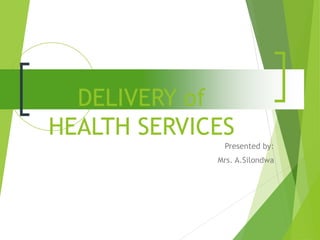
Health Reforms Zambia.ppt
- 1. DELIVERY of HEALTH SERVICES Presented by: Mrs. A.Silondwa
- 2. SPECIFIC Objectives BY the end of this course, the student will be able to: Describe the roles of hospital and health centers Discuss public/private partnership Discuss equity of access in health service delivery Describe the priority setting in health
- 3. Course Content Overview Roles of the hospitals and health centers Public/private provision of health services Equity in health services delivery Priority setting in health
- 4. Overview A well functioning health system working in harmony is built on having trained motivated health workers a well maintained infrastructure and a reliable supply of medicines and technologies backed by adequate funding strong health plans and evidenced based policies
- 5. Overview (1) Mission Statement: To provide equitable access to cost effective, quality health services as close to the family as possible Efficient and Effective health service delivery Reliable, transparent and acceptable governance systems and structures
- 6. Overview (2) Reliable, timely and comprehensive information systems Adequate infrastructure, medical equipment and other technologies Competent health workers at the point of services delivery Stable predictable and equitable financing
- 7. Overview 3 Service delivery is when the inputs are organized and managed to ensure improved access to services Delivery of health services should have an impact on peoples health People should be covered by a broad spectrum of health services from preventive health services to curative services, rehabilitative services and palliative care for peoples ends of lives Ensuring services are of good quality, safe for people to consume including continuity of care across services as people interact with the health system
- 8. Delivery of Health Care Services Basic essential health care package at each level of care in order to achieve WHO three major goals
- 9. Roles of health centres Health centre (primary level) the first contact level where people first interact with the overall health system WHO and many world public health emphasizes the vital importance of primary health care in improving health centers Essential health care based on values of universal access, equity, participation and intersectoral action, working with other sectors that impact on health
- 10. Roles of District Health Office Primary management unit in the decentralised health system Administer the affairs of the district health services Responsible for planning for the district Responsible for ensuring that local priorities are recognised and addressed Responsible for coordinating with other sectors e.g. agriculture, local government, etc. Responsible for monitoring performance of HCs and level 1 hospitals against established standards Responsible for providing training to district staff
- 11. Roles of Hospitals(2) Hospitals have certain unique roles and attributes The improvement of community health status The integral relationship of the hospital within the community Access to care for those in need of services The obligation to provide high quality health care services Recognition that public expectations from non profit and public hospitals are unique The importance of fiscal responsibility in ensuring the long-term commitment of hospitals to their communities
- 12. Roles of hospitals(3) The maintenance of traditional values of compassion and charity Voluntary governance and accountability to the community. The governing body of the hospital provides the critical linkage between the values of the community and the day-to-day operations of a complex health organization The physician-hospital relationship - The leadership and hospital management work in partnership with the medical staff to create the delicate and vital balance between institutional imperatives and professional
- 13. Private/Public Health services The health sector in Zambia is liberalised and embraces diversity in ownership, including: Public health sector - health facilities and programmes under the MOH, and some government line ministries and departments; Faith-based health sector, under the coordination of CHAZ; Private sector: for- and not-for profit health services, owned by private investors and Civil Society Organisations (CSOs); Traditional and alternative health service providers, ALL operate informally and are not regulated or monitored by MOH.
- 14. Equity in health services Mission Statement:To provide equitable access to cost effective, quality health services as close to the family as possible Vision: To improve the health status of people in Zambia in order to contribute to socio-economic development Key Principles: Primary Health Care (PHC) approach; Equity of access; Affordability; Cost-effectiveness; Accountability; Partnerships; Decentralisation and Leadership; Clean, Caring and Competent health care environment
- 15. Equity in Health Services(2) Efforts aimed to improve access to health services are: Abolition of user fees in 54 rural districts, Construction and renovation of health facilities across the country, Investments in medical equipment and transport, Availability of essential drugs and medical supplies Scaling up of outreach health services Health promotion and education Equities in income levels at household level.
- 16. Priority setting in Health 1.Public Health Priorities : Primary health care services. Maternal, neonatal and child health. Communicable diseases, especially malaria, HIV and AIDS, STIs and TB. Non-Communicable Diseases (NCDs). Epidemics control and public health surveillance. Environmental health and food safety. Health service referral systems. Health promotion and education
- 17. Priority Setting in Health (2) 2.Health System Priorities: Human Resources for Health (HRH). Essential drugs and medical supplies. Infrastructure and Equipment. Health information. Health care financing. Health Systems Governance
- 18. CONCLUSION Health service delivery and improving services = quality of services Measuring out patient attendance or deliveries of babies in health units is not good enough. Services will only have an impact on peoples health if they are efficient ,effective, safe and good quality health care Measuring the quality of service involves; technical quality, medicines work and consumer’s perceptions (treated with dignity, seen on time, friendly)
- 19. Thank you